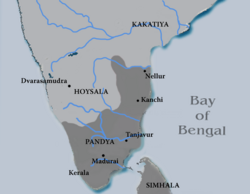Pandya dynasty
Appearance
Pandyan dynasty | |
|---|---|
| 400 BCE–1618 CE | |
|
A close depiction of Tenkasi Pandiya flag as per archaeological findings and historians illustration.[1] | |
 Greatest extent of the Pandya Empire, 13th Century | |
| Capital | |
| Official languages | |
| Religion | |
| Government | Monarchy |
• Around 270 BCE | Nedunjeliyan I (first documented) |
• 560–590 CE | Kadungon (Pandya revival) |
• 1613–1618 CE | Varagunarama |
| Historical era | Medieval era |
• Established | 400 BCE |
• Disestablished | 1618 CE |
| Today part of | India Sri Lanka |
The Pandyan kingdom பாண்டியர் was an ancient Tamil state in South India of unknown antiquity. Pandyas were one of the three ancient Tamil kingdoms (Chola and Chera being the other two) who ruled the Tamil country from pre-historic times until end of the 15th century. They ruled initially from Korkai, a sea port on the southern most tip of the Indian peninsula, and in later times moved to Madurai.
- ↑ Walter Codrington, Hubert (1975). Ceylon Coins and Currency. Asian Educational Services. ISBN 9788120609136.
- ↑ "Classical Indo-Roman Trade". Economic and Political Weekly. 48 (26–27). 2015-06-05.
- ↑ 3.0 3.1 Cite error: The named reference
Fallwas used but no text was provided for refs named (see the help page). - ↑ Upinder Singh (2008). A History of Ancient and Early Medieval India: From the Stone Age to the 12th Century. Pearson Education India. p. 46. ISBN 978-81-317-1120-0.
Kings of the Chola and Pandya dynasties also issued Tamil and bilingual Tamil inscriptions.
- ↑ C. Sivaramamurti (1977). L'Art en Inde. H. N. Abrams. p. 60. ISBN 978-0-8109-0630-3.
Thus the state language was whether the inscriptions were from the north or the south and whether the dynasty was Gupta, Vakatak[a], Vardhana, Maukhari, Pratihara, Paramara, Chandella, Pala, Sena, Gahadavala, Haihaya, Ganga, Pallava, Chola, Pandya, Chalukya, Rashtrakuta, or Vijayanagar[a]. Inscriptions were sometimes written in regional languages, but they invariably had a preface in Sanskrit.
- ↑ Thapar, Romila. "India – Society and Culture (8th–13th century)". Encyclopædia Britannica. Retrieved 2021-01-22.
- ↑ Schwartzberg, Joseph E. (1978). A Historical Atlas of South Asia. Chicago: University of Chicago Press. p. 146, map XIV.2 (b). ISBN 0226742210.

